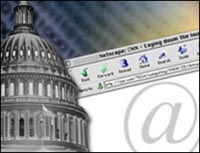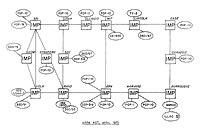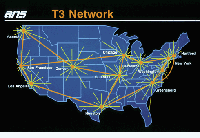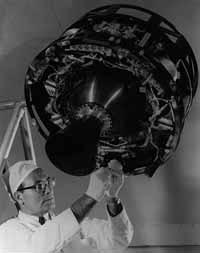| (insert your NIE or newspaper logo here) |
Weekly Online LessonOnline Lesson ArchiveGrade Level: 6-10
|
America's High-Speed Future
 During a recent speech in
Albuquerque, New Mexico, President George W. Bush told the audience how affordable broadband Internet access is critical to keep America competitive, connected, and educated.
During a recent speech in
Albuquerque, New Mexico, President George W. Bush told the audience how affordable broadband Internet access is critical to keep America competitive, connected, and educated.
On Friday, March 26, 2004, Bush stated that, "We ought to have a universal, affordable access for broadband technology by the year 2007."
That's an important goal, Bush explained, because the more affordable broadband technology is -- which typically happens when the number of carriers competing for subscribers rises -- then the more high-speed Internet users there will be.
Therefore, the exchange of ideas and information between individuals, businesses, and educators should grow and get faster. Reaching this goal, Bush contends, will help ensure that "America will stay on the competitive edge of world trade."
The federal government's push for affordable broadband began with the Telecommunications Act of 1996, which was developed "to encourage deployment of advanced telecommunications capability in the United States on a reasonable and timely basis." Over the next six months, the Federal Communications Commission (FCC) will be investigating the success of this initiative, including how it may influence the global economy and how high-speed availability varies between areas.
About a week before President Bush's remarks, Nielsen/NetRatings, the global standard for Internet audience measurement and analysis, reported that three of four Americans have access to the Internet -- that's about 204.3 million people. As of June 2003, the FCC found that about 23.5 million had high-speed connections, and the number of broadband providers and subscribers continues to grow.
So how does the Internet work? What exactly is the difference between a dial-up and a broadband connection besides speed? To answer these questions and more, this week's lesson will lead you through the network of digital connecting and land you in nerd world for a glimpse at how the Internet was born.
Basic Connections
 The first thing to do is to understand How Internet Infrastructure Works at the HowStuffWorks website. Throughout this site, you can click on any of the underlined words to learn more about that term, then just use your browser's Back button to return to where you left the main topic.
The first thing to do is to understand How Internet Infrastructure Works at the HowStuffWorks website. Throughout this site, you can click on any of the underlined words to learn more about that term, then just use your browser's Back button to return to where you left the main topic.
Read through the introduction. How many host computer systems existed in 1969? What role does The Internet Society play?
Move on to the next page and see how A Hierarchy of Networks works. What's the difference between an ISP, a LAN, a POP, and an NAP?
Next, discover how routers help for Bridging the Divide. What exactly is a backbone?
But the Internet wouldn't be able to function very well without some type of standard for organizing all of the interconnected pieces. Hence the Protocol of the Internet was created. Why is a unique IP address important?
 How is this protocol connected with What's In A Name? How does a DNS fit into all of this? What exactly does a Web Server do?
How is this protocol connected with What's In A Name? How does a DNS fit into all of this? What exactly does a Web Server do?
Another site here at HowStuffWorks will help you understand How DSL Works. What words do the letters DSL represent?
Also, find out how Telephone Lines are used to provide this high-speed connection, how Asymmetrical DSL differs from other DSL types, and why there are Distance Limitations. Why can't loading coils boost ADSL signals like they do regular telephone signals?
Next, uncover the ins and outs of splitting the signal using a CAP system, DMT system, and Filters. Can you describe the differences between the three methods?
To actually use a DSL connection, a user will still need some DSL Equipment, including a Transceiver. Plus, your server needs to have a DSLAM.
So now that you've explored the nature of the Web and DSL, how do they all fit together to offer a rapid exchange of ideas and information between two high-speed Internet users?
Triumph of the Nerds 2.0.1
 Some refer to them "nerds" and others call them "geeks," but no matter your preference, without them the Internet would have never existed.
Some refer to them "nerds" and others call them "geeks," but no matter your preference, without them the Internet would have never existed.
Enter the Nerds 2.0.1, who you'll meet through Robert X. Cringley at PBS. If you have time, you can jump off into one of the underlined topics -- just hit your browser's Back button to return to the main chapter.
Begin your exploration of geek-dom with Networking the Nerds. How did America's involvement in war fuel technological developments? What was the ARPAnet? Why do you think was there a "transfer of the Internet" from the Nerds to Serving the Suits? How did the shift in who used computers influence the growth of networks?
The next step, of course, was Wiring the World. Who named the project the World Wide Web? What was the first graphical browser, and why was it critical to the widespread success of computer networking? Why didn't Microsoft jump onto the Internet until 1995?
If you'd like, check out the site's complete Cast of Characters to get an idea of how these different people contributed to the success of the Internet. Use the Glossary of Geek and the Timeline as additional helpful guides.
Lastly, take the Quiz to see what you've learned. Using your new Internet knowledge, can you explain, step-by-step, how the process of taking the quiz worked -- beginning when the quiz page opened in your browser and ending when your quiz results got displayed?
Newspaper Activities
In a current issue of Targetnewspaper look for articles about the Internet -- like, maybe there's a particular website in the spotlight, or a new high-speed service opened in town. In what ways does or might the new website, high-speed service, or other related news item help consumers, as well as manufacturers and other businesses? Does the news influence education in any way? Also, look through your newspaper to find any advertisements for Internet service. How many different companies did you find? How many provide dial-up access? How many offer DSL? How about wireless connections? How do the monthly fees compare?
© Copyright 2004
Learners
Online,
Inc.
